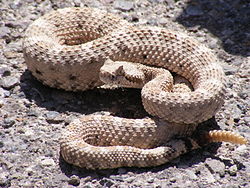Fauna of California
Common animals that live throughout all the state include raccoons, weasels, otters, beavers, hawks, lizards, owls, coyotes, skunks, snakes, cougars, black bears, deer, squirrels, and whales.
Another bird which winters in California is the American white pelican which is a large seabird, with a wingspan reaching up to 9 feet 2 inches (280 cm).
[5] The forests in northern parts of California have an abundant fauna, which includes for instance the black-tailed deer, black bear, gray fox, North American cougar, bobcat, and Roosevelt elk.
Gray wolves began repopulating California in 2011 as they entered Lassen, Siskiyou, and Plumas counties from the Cascade Range of Oregon.
The only bird native to the high Arctic region is the gray-crowned rosy finch, but others often visit, including Anna's hummingbird and Clark's nutcracker.
Some animals in the Yosemite Valley include bobcats, mountain lions, ring-tailed cats, the Steller's jay, California ground squirrels, and the American black bear.
[8] Birds in the region include American robin, bald eagle, California gull, Canada goose, dark-eyed junco, hairy woodpecker, mallard, mountain chickadee, red-tailed hawk, Steller's jay, western tanager, and yellow-headed blackbird.
[10] The vast forested Klamath Mountains in Northern California, coupled with a low rate of human settlement in the rugged remote terrain, makes for excellent habitat for a number of species.
Big Sur is a region of the Central Coast of California where the Santa Lucia Mountains rise abruptly from the Pacific Ocean.
Mammals include bobcat, weasel, coyote, gray fox, and puma, as well as non-native Russian boar which were imported in the 1920s for sport hunting to Rancho San Carlos and can now be found in 56 of the state's 58 counties.
[15] Many varieties of seabirds and waterfowl also call it home, including seagulls, cormorants, willets, sandpipers, oystercatchers, guillemots, and many others.
Southern California constitutes one of the more varied collections of geologic, topographic, and natural ecosystem landscapes in a diversity outnumbering other major regions in the country.
The region spans from Pacific Channel Islands, shorelines, beaches, and coastal plains, through the Transverse and Peninsular Ranges with their peaks, into the large and small interior valleys, to the vast deserts of California.
The western screech owl,[18] roadrunner, cactus wren, and various species of hawk are common birds, and the sidewinder, desert tortoise, and horned toad represent the area's reptilian life.
Animals along the river include several species of snakes, scorpions, tarantula, yellow-headed blackbird, desert iguana, kit fox, bobcats, and coyotes.
Introduced mammal species include feral pigs, cats, rats, deer, cattle, the Santa Cruz sheep, and the Catalina Island bison herd.
Marine life ranges from microscopic plankton to the endangered blue whale, the largest animal ever to live on earth.
[21] The oceans surrounding the islands have rich marine life; species include orcas, swellshark, bat ray, California moray, great white shark, and sea lions.






